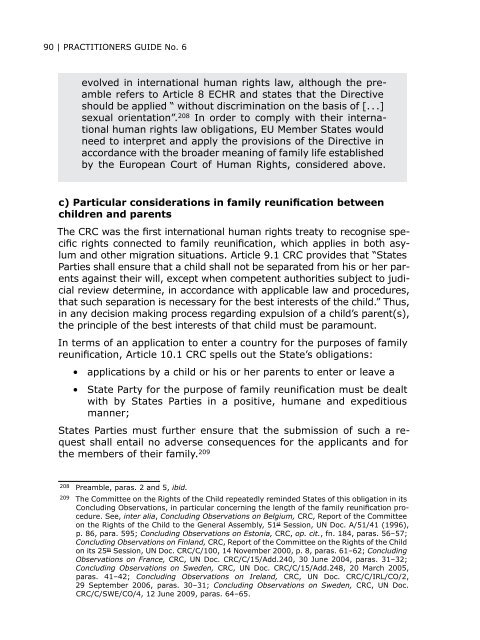Universal-MigrationHRlaw-PG-no-6-Publications-PractitionersGuide-2014-eng
Universal-MigrationHRlaw-PG-no-6-Publications-PractitionersGuide-2014-eng
Universal-MigrationHRlaw-PG-no-6-Publications-PractitionersGuide-2014-eng
Create successful ePaper yourself
Turn your PDF publications into a flip-book with our unique Google optimized e-Paper software.
90 | PRACTITIONERS GUIDE No. 6<br />
evolved in international human rights law, although the preamble<br />
refers to Article 8 ECHR and states that the Directive<br />
should be applied “ without discrimination on the basis of [. . .]<br />
sexual orientation”. 208 In order to comply with their international<br />
human rights law obligations, EU Member States would<br />
need to interpret and apply the provisions of the Directive in<br />
accordance with the broader meaning of family life established<br />
by the European Court of Human Rights, considered above.<br />
c) Particular considerations in family reunification between<br />
children and parents<br />
The CRC was the first international human rights treaty to recognise specific<br />
rights connected to family reunification, which applies in both asylum<br />
and other migration situations. Article 9.1 CRC provides that “States<br />
Parties shall ensure that a child shall <strong>no</strong>t be separated from his or her parents<br />
against their will, except when competent authorities subject to judicial<br />
review determine, in accordance with applicable law and procedures,<br />
that such separation is necessary for the best interests of the child.” Thus,<br />
in any decision making process regarding expulsion of a child’s parent(s),<br />
the principle of the best interests of that child must be paramount.<br />
In terms of an application to enter a country for the purposes of family<br />
reunification, Article 10.1 CRC spells out the State’s obligations:<br />
• applications by a child or his or her parents to enter or leave a<br />
• State Party for the purpose of family reunification must be dealt<br />
with by States Parties in a positive, humane and expeditious<br />
manner;<br />
States Parties must further ensure that the submission of such a request<br />
shall entail <strong>no</strong> adverse consequences for the applicants and for<br />
the members of their family. 209<br />
208 Preamble, paras. 2 and 5, ibid.<br />
209 The Committee on the Rights of the Child repeatedly reminded States of this obligation in its<br />
Concluding Observations, in particular concerning the l<strong>eng</strong>th of the family reunification procedure.<br />
See, inter alia, Concluding Observations on Belgium, CRC, Report of the Committee<br />
on the Rights of the Child to the General Assembly, 51 st Session, UN Doc. A/51/41 (1996),<br />
p. 86, para. 595; Concluding Observations on Estonia, CRC, op. cit., fn. 184, paras. 56–57;<br />
Concluding Observations on Finland, CRC, Report of the Committee on the Rights of the Child<br />
on its 25 th Session, UN Doc. CRC/C/100, 14 November 2000, p. 8, paras. 61–62; Concluding<br />
Observations on France, CRC, UN Doc. CRC/C/15/Add.240, 30 June 2004, paras. 31–32;<br />
Concluding Observations on Sweden, CRC, UN Doc. CRC/C/15/Add.248, 20 March 2005,<br />
paras. 41–42; Concluding Observations on Ireland, CRC, UN Doc. CRC/C/IRL/CO/2,<br />
29 September 2006, paras. 30–31; Concluding Observations on Sweden, CRC, UN Doc.<br />
CRC/C/SWE/CO/4, 12 June 2009, paras. 64–65.



